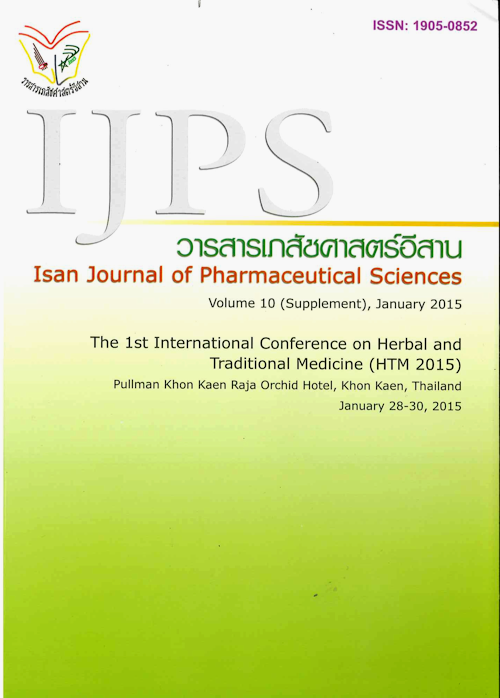Determination on Antioxidant Capacity and TLC Analysis of Ten Thai Russula Mushroom Extracts
Main Article Content
Abstract
Introduction: Russula mushrooms have been popularly consumed as indigenous foods and
used in the treatments of various diseases in the Northeastern region of Thailand for long time.
Method: This study was carried out to investigate the antioxidant capacities of selected Russula
mushrooms and their chemical profi les. All extracts from ten Russula mushrooms including R.
crustosa, R. delica, R. monspeliensis, R. velenovskyi, R. virescens, R. lepida, R. alboareolata, R.
paludosa, R. medullata and R. helios were prepared by maceration with 95% ethanol. Their antioxidant
capacities were determined on superoxide radical scavenging using photochemiluminescence (PCL)
assay for both lipid-soluble and water-soluble antioxidant capacities (ACL and ACW, respectively).
Results: All Russula mushroom extracts exhibited antioxidant capacities in various ranges. R.
medullata extract possessed the highest antioxidant effects in both ACL and ACW models with the
antioxidant capacities of 1.1658 nmol of trolox equivalence and 1.323 nmol of ascorbic acid equivalence,
respectively. Phytochemical analysis of all Russula mushroom extracts was conducted by thin layer
chromatographic (TLC) technique. Conclution: This information supports the uses of Russula
mushrooms for health and medicinal purposes.
Article Details
In the case that some parts are used by others The author must Confirm that obtaining permission to use some of the original authors. And must attach evidence That the permission has been included
References
Buyck B, Hofstetter V, Eberhardt U, Verbeken A, Kauff F. Walking the thin line between Russula and Lactarius: the dilemma of Russula subsect. Ochricompactae. Fungal Diversity. 2008; 28: 15-40.
Chen X-H, Xia L-X, Zhou H-B, Qiu G-Z. Chemical Composition and Antioxidant Activities of Russula griseocarnosa sp. nov. Journal Agricultural Food Chemistry. 2010; 58: 6966–71.
Clericuzio M, Cassino C, Corana F, Vidari G. Terpenoids from Russula lepida and Russula amarissima (Basidiomycota, Russulaceae). Phytochemistry. 2012; 84: 154–9.
Dasgupta A, Ray D, Chatterjee A, Roy A, Ach-arya K. Antioxidative effect of polyphenol-rich extract of Russula albonigra. Research Journal of Pharmaceutical, Biological and Chemical Sciences. 2014; 5(1): 510-20.
David G, Spoerke, Barry H. Rumack. Mushroom Poisoning Diagnosis and Treatment. 1942: 360-361.
Hur SJ, Choi SY, Lim BO. In Vitro anti-infl amma-tory activity of Russula virescens in the macrophage like cell line RAW 264.7 activated by lipopolysaccharide. Journal of Nutrition & Food Sciences. 2012; 2(4).
Jaruntorn B, Chanida H. Spatial distribution of Beta glucan containing wild mushroom communities in subtropical dry forest, Thailand. Fungal Diversity. 2010; 46(1): 29-42.
Jain N, Pande V. Diversity analysis of ectomycor-rhizal genus Russula using RAPD mark-ers Octa Journal of Environmental Re-search. 2013;1(4).
Jian-Wen T, Ze-Jun D, Ji-Kai L. New Terpenoids from Basidiomycetes Russula lepida. Helvetica Chimica Acta 2000; 83: 3191-7.
Joshi S, Bhatt RP, Stephenson SL. The current status of the family Russulaceae in the Uttarakhand Himalaya, India. Myco-sphere. 2012; 3(4): 486-501.
Kalogeropoulos N, Yanni AE, Koutrotsios G, Aloupi M. Bioactive microconstituents and antioxidant properties of wild edible mushrooms from the island of Lesvos, Greece. Food and Chemical Toxicology 2013; 55: 378–85.
Khatua S, Paul S, Chatterjee A, Ray D, Roy A, Acharya K. Fraction of Russula delicashows in vitro antioxidant property influenced by polyphenols. International Journal of Pharmaceutical Sciences Review and Research. 2013; 23(2): 368-73.
Manassila M, Sooksa-Nguan T, Boonkerd N, Rodtongb S, Teaumroonga N. Phylogenetic diversity of wild edible Russula from Northeastern Thailand on the basis of internal transcribed spacer sequence. Science Asia. 2005; 31: 323-8.
Po-Tsang Lee M, Ming-Ling Wu, MD, Wei-Jen Tsai, MD, Jiin Ger, MD, Jou-Fang Deng, MD, and Hsiao-Min Chung, MD. Rhabdomyolysis: an unusual feature with mushroom poisoning. American Journal of Kidney diseases. 2001; 38( 4 ): 1-5.
Quiñónez-Martínez M, Ruan-Soto F, Aguilar-Moreno IE, Garza-Ocañas F, Lebgue-Keleng T, Lavín-Murcio PA, et al. Knowl-edge and use of edible mushrooms in two municipalities of the Sierra Tarahumara, Chihuahua, Mexico. Ethno-biology and Ethnomedicine 2014. 2014; 10(67): 1-13.
Sanmeea R, Dellb B, Lumyongc P, Izumorid K, Lumyong S. Nutritive value of popular wild edible mushrooms from northern Thailand. Food Chemistry. 2003; 82: 527–32
Sies H. Oxidative stress: Oxidants and antioxidants. Experimental Physiology. 1997; 82(2): 291-5.
Sutachit S, Sutachit M. Medicinal Mushrooms: Past, Presentand Future’, Hed Thai 2545; 2002. 1-11.
Turkoglu A, Duru ME, M. Antioxidant and antimicrobial activity of Russula delica Fr: an edible wild mushroom. Eurasian Journal of Analytical Chemistry. 2007; 2(1): 54-67.
Wang J, Wang H.X, Ng T.B. A peptide with HIV-1 reverse transcriptase inhibitory activity from the medicinal mushroom Russula paludosa. Peptides 2007; 28: 560-55.
Yaltirak T, Aslim B, Ozturk S, Alli H. Antimicro-bial and antioxidant activities of Russula delica Fr. Food and Chemical Toxicology. 2009; 47:2052–6.
Zhang G, Sun J, Wang H.X, Ng T.B. First isolation and characterization of a novel lectin with potent antitumor activity from a Russulamushroom. Phytomedicine. 2010;1 7:775-81.


